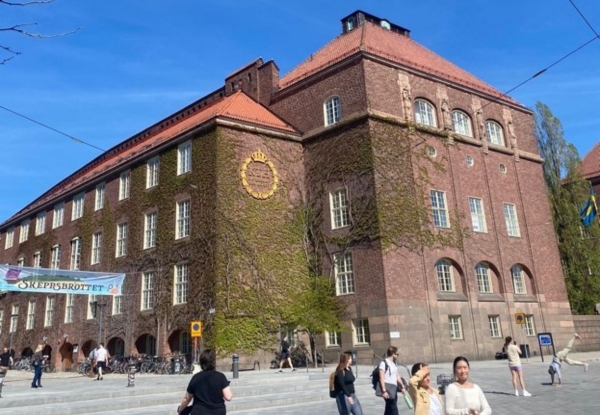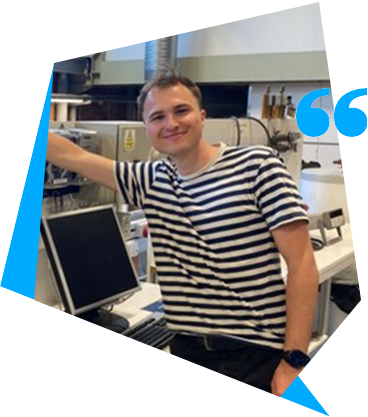< back to articles
10 months at KTH for Quentin
Published on
Quentin left a year ago and returned from his Swedish adventure last June. The Foundation had awarded him a mobility grant for a diploma course at the Royal Institute of Technology to develop his skills in the field of renewable energies.
He tells you all about his stay!

The ISAE-SUPAERO Foundation supported me during my stay at the Royal Institute of Technology (KTH) in Sweden to study for a Master’s degree in renewable energies. Currently an engineering student at ISAE-SUPAERO, I chose to do this Master’s degree during my gap year, in order to develop my skills in the field of renewable energies, which I intend to put at the heart of my career. This stay was therefore of vital importance to my personal and professional development.
This year at KTH has been a decisive step in my career, enabling me to clarify my ambitions and prepare myself effectively to make a significant contribution to the renewable energy sector.
Why did you choose to study at KTH?
Quentin Largeron

I studied mathematics and physics at the University of Avignon. I discovered a strong interest in fluid dynamics. That’s why I chose to join ISAE-SUPAERO, to continue studying the subject in depth. During my first year at the Institute, I was able to take part in a variety of conferences, and talk to research professors and fellow students about environmental issues. It was a real wake-up call, and I wanted to get fully involved in the subject. I quickly realized that energy issues are intimately linked with climate change, and that these subjects are rarely taught at school. That’s why I decided to take advantage of my gap year to develop my skills in this area. KTH was an obvious choice for this Master’s degree, as the school has an international reputation, particularly for its energy department. What’s more, I’d been able to travel to Sweden in the past, and the country’s atmosphere and culture had intrigued me, and I knew I wanted to go back for a long stay.
Tell us about the Master’s degree you chose to enter?
So I joined KTH’s renewable energies master’s program. Within this master’s program, there are various career paths: energy production, energy for buildings, energy management. I chose to follow the energy path for buildings. As I’m already aware of the issues surrounding energy efficiency in buildings, I wanted to find out more about the subject. So I was able to take courses on heat pumps, photovoltaic systems, geothermal technology and a larger course on the design of systems integrating these three technologies to optimize the energy consumption of buildings. Sweden is a pioneering country in this field, with a large number of projects involving local authorities pooling their energy production.
In related courses, I was able to study energy storage technologies, which are all the more important when it comes to renewable energies. Moving from battery technologies to thermal energy storage, it was really rewarding. I also attended a course on the large-scale production of electricity and heat. As Sweden is a Nordic country, the need for heating in winter is critical, and so the means put in place to meet this need must be studied. Finally, I took a course on nuclear reactor technology. As nuclear energy is not included in the renewable energies curriculum, I asked the school if I could take a course from another master’s program to study the subject, which is so important. Indeed, nuclear power is present in most energy transition scenarios. As I wanted to work in the energy sector, I felt it was essential to have some basic knowledge of the subject. The course was fascinating, and despite its technical nature and my lack of knowledge on the subject, the teachers were able to support me and the students.
The teaching methods were also surprising for me. Contrary to what I’m used to, there is no guided exercise session to dig deeper into the course. There are only lectures in the amphitheatre and the course is mainly assessed through group projects. I find the group project format very rewarding. First of all, it allows you to meet new people from all over the world, and work with people who don’t necessarily have the same working methods. Secondly, project topics are generally very concrete and comprehensive. Starting with a literature search, actual needs are identified and any calculations or studies are carried out with the aim of advancing general knowledge on the subject.
What do you remember about life in Sweden?
My stay was also a cultural enrichment. My wish in coming to Sweden was to immerse myself in the country’s culture, which I was able to do. Being very far north, the country’s seasons are extremely marked, and behavior changes radically depending on the season and the region of the country. The rail network is very well developed, so I was able to travel easily by sleeper train throughout the country in all seasons. I wanted to experience the polar cold and observe how people adapt to these conditions. So I took a 10-day trip to Swedish Lapland in the middle of winter. During this period, the sun only rises for 2 hours a day. It was an extraordinary experience. I observed that the populations did not seem to be disturbed by this radical change, but adapted perfectly.


During my stay, I also had the opportunity to visit Norway, a country that attracted me as much as Sweden. I was amazed by the majestic scenery of the fjords around Bergen. During an all-electric boat trip on the Naerofjord, I was able to put into practice the knowledge I had acquired during a course on sustainable transport at KTH. I had a long chat with the catamaran’s captain, who showed me around the engine room, batteries and motor. We debated the sustainable aspect of this mode of transport, although we had differing points of view, particularly on climate impacts. I was surprised that someone so knowledgeable about these issues could be a climate skeptic. However, our exchanges remained cordial and enriching. It was particularly instructive to see in action a transport system that we had studied in the course of our work.
Sweden is a country with a very strong sporting culture, and that had a big impact on me. This culture focuses mainly on individual sports such as running, cycling and cross-country skiing. Having never tried cross-country skiing, I was fascinated to see that in Stockholm, as soon as the first snow falls in October, numerous trails open up all over the city. So I decided to take up this sport, which is both physical and technical. To motivate myself, I decided to enter the sport’s most emblematic race: the Vasaloppet, with a friend from ISAE-SUPAERO who, like me, was just discovering the sport. We trained intensively for most of the winter. We even spent a week in Östersund, home of the World Biathlon Championships. During our training sessions, we sometimes skied alongside, and often behind, the skiers from the Swedish national team. It was impressive. The race took place in February, and together we covered the 90 km of cross-country skiing through the Swedish countryside, alongside over 15,000 participants. The atmosphere was magical, with many locals coming to watch the race and cheer on the participants along the 90 km route. The finish was an emotional one, marking the culmination of over three months of hard physical training. It was one of the highlights of my stay.
If you had to sum up your year?
When I arrived in Sweden, I had no idea that a one-year Master’s degree in renewable energies would have such a profound impact on me. Initially, I saw this experience simply as an opportunity to deepen my knowledge of the energy aspects of climate change. However, this year turned out to be much more rewarding than expected. Right from the start, the courses on the energy supply of buildings, whether electricity or heat, captured my attention. I was fascinated by the impact and energy consumption of buildings in France, realizing the crucial importance of this sector. This prompted me to deepen my knowledge and adapt my academic path. I have modified my second semester program to include more courses focusing on building energy efficiency and electricity and heat production..
These new courses have enabled me to work on system design projects combining heat pumps, solar panels and geothermal energy. These projects were extremely exciting and confirmed my interest in this field. I then decided to make building energy efficiency my core business.
In anticipation of my final year at the institute, which I’d like to complete under a professionalization contract, I’ve contacted several design offices specializing in this field. The interviews I conducted enabled me to gain a more detailed understanding of the role of these design offices in implementing projects aimed at reducing the environmental impact of buildings. I was particularly attracted by the technical aspects of design and project management.
At the same time, I spoke with professors at KTH to confirm my desire to work in this sector. I’ve learned that research in this field is still at an early stage. The technologies used, although well known and mastered, require in-depth research into their implementation, impact and social acceptance. This challenge, combined with the technical nature and environmental importance of the sector, definitely convinced me to pursue a career in building energy efficiency. So.., The year I spent in Sweden was decisive for my professional future. Not only did it enable me to acquire invaluable technical skills, it also helped me to clearly define my career path.
Any final words?
This year in Sweden has been a transforming experience, both personally and professionally. My time at KTH exceeded my initial expectations, enabling me to develop in-depth skills in the field of renewable energies, particularly in building energy efficiency. This immersion in a world-renowned academic environment, combined with a rich cultural experience and stimulating interactions with professionals and experts, has strengthened my determination to pursue a career in this crucial sector for the future.
The opportunity to work on concrete, innovative projects, such as the design of systems combining heat pumps, solar panels and geothermal energy, was particularly rewarding. These projects not only consolidated my technical knowledge, but also confirmed my passion for energy efficiency in buildings. In addition, discussions with KTH professors and professionals from specialized engineering firms gave me a clear vision of the challenges and opportunities in this field.
This year of study and discovery was also marked by highlights such as my participation in the Vasaloppet, which added a unique dimension to my stay. These experiences not only contributed to my personal development, but also gave me a better understanding and appreciation of Swedish culture.